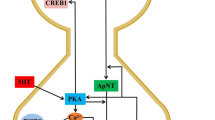Abstract
Norepinephrine added in vitro to nerve ending membranes from rat cerebral cortex stimulates the activity of (Na+, K+) adenosinetriphosphatase (ATPase) only in the presence of the soluble brain fraction. In its absence norepinephrine inhibits the enzyme. (Mg2+)ATPase also showed stimulation by norepinephrine in the presence of the soluble fraction, but of lesser magnitude. The activation of (Na+, K+)ATPase by norepinephrine is not reproduced by cyclic AMP and is not antagonized by either α- or β-adrenergic blocking agents. These results suggest that the stimulation caused by norepinephrine is a direct effect on the enzyme and is not mediated by cyclic AMP or adrenergic receptors.
Similar content being viewed by others
References
Yoshimura, K. 1973. Activation of Na−K activated ATPase in rat brain by catecholamine. J. Biochem. 74:389–391.
Godfraind, T., Kock, M. C., andVerbeke, N. 1974. The action of EGTA on the catecholamines stimulation of rat brain Na−K-ATPase. Biochem. Pharmacol. 23:3505–3511.
Iwangoff, P., Enz, A., andChappius, A. 1974. Effect of adrenergic blockers on the activation of brain ATPase by noradrenaline. Experientia 30:688.
Chappius, A., Enz, A., andIwangoff, P. 1975. Some comments on the adrenergic regulation of the (Na+K+) ATPase system in the brain. Triangle 14:96–98.
Gilbert, J. C., Wyllie, M. G., andDavison, D. V. 1975. Nerve terminal ATPase as possible trigger for neurotransmitter release. Nature 255:237–238.
Schaefer, A., Unyi, G., andPfeifer, A. K. 1972. The effects of a soluble factor and of catecholamines on the activity of adenosine triphosphatase in subcellular fractions of rat brain. Biochem. Pharmacol. 21:2289–2294.
Logan, J. G., andO'Donovan, D. J. O. 1976. The effects of ouabain and the activation of neural membrane ATPase by biogenic amines. J. Neurochem. 27:185–189.
Rodriguez de Lores Arnaiz, G., Alberici M., andDe Robertis, E. 1967. Ultrastructural and enzymic studies of cholinergic and non-cholinergic synaptic membranes isolated from brain cortex. J. Neurochem. 14:215–225.
Albers, R. W., Rodriguez de Lores Arnaiz, G., andde Robertis, E. 1965. Sodium-potassium-activated ATPase and potassium activatedp-nitrophenylphosphatase: A comparison of their subcellular localizations in rat brain. Proc. Natl. Acad. Sci. U.S.A. 53:557–564.
Lowry, O. H., andLopez, J. A. 1946. Determination of inorganic phosphate in presence of labile P esters. J. Biol. Chem. 162:421–428.
Lowry, O. H., Rosebrough, N. J., Farr, A. L., andRandall, R. J. 1951. Protein measurement with the Folin phenol reagent. J. Biol. Chem. 193:265–275.
Beauge, L. A. andGlynn, I. M. 1977. A modifier of (Na+−K+)ATPase in commercial ATP. Nature 268:355–356.
Hudgins, P. M., andBond, G. H. 1977. (Mg2+−K+) dependent inhibition of Na+K+ATPase due to a contaminant in equine muscle ATP. Biochim. Biophys. Res. Commun. 77:1024–1029.
Josephson, L., andCantley, C., Jr. 1977. Isolation of a potent (Na+−K+) ATPase inhibitor from striated muscle. Biochemistry 16:4572–4578.
Fagan, J. B., andRacker, E. 1977. Reversible inhibition of (Na+, K+) ATPase by Mg2+, adenosine triphosphate, and K+. Biochemistry 16:152–158.
Rodriguez de Lores Arnaiz, G., andde Robertis, E. 1972. Properties of the isolated nerve endings. Pages 237–272,in Bronner, F., and Kleinzeller, A. (eds.), Current Topics in Membranes and Transport, Vol. 3, Academic Press, New York.
Shaefer, A., Seregi, A., andKomlos, M. 1974. Ascorbic acid-like effect of the soluble fraction of rat brain on adenosine triphosphatases and its relation to catecholamines and chelating agents. Biochem. Pharmacol. 23:2257–2271.
De Robertis, E., Rodriguez de Lores Arnaiz, G., Salganicoff, L., Pellegrino de Iraldi, A., andZieher, L. M. 1963. Isolation of synaptic vesicles and structural organization of the acetylcholine system within brain nerve ending. J. Neurochem. 10:225–235.
De Robertis, E., Rodriguez de Lores Arnaiz, G., Alberici, M., Butcher, R. W., andSutherland, E. W. 1967. Subcellular distribution of adenyl cyclase and cyclic phosphodiesterase in rat brain cortex. J. Biol. Chem. 242:3487–3493.
De Robertis, E. 1975. Synaptic Receptors. Modern Pharmacology-Toxycology. Vol. 4, Marcel Dekker, New York.
Phillis, J. W. 1974. The role of calcium in the central effects of biogenic amines. Life Sciences 14:1184–1201.
Author information
Authors and Affiliations
Rights and permissions
About this article
Cite this article
Rodriguez de Lores Arnaiz, G., Mistrorigo de Pacheco, M. Regulation of (Na+, K+) adenosinetriphosphatase of nerve ending membranes. Neurochem Res 3, 733–744 (1978). https://doi.org/10.1007/BF00965996
Accepted:
Issue Date:
DOI: https://doi.org/10.1007/BF00965996




